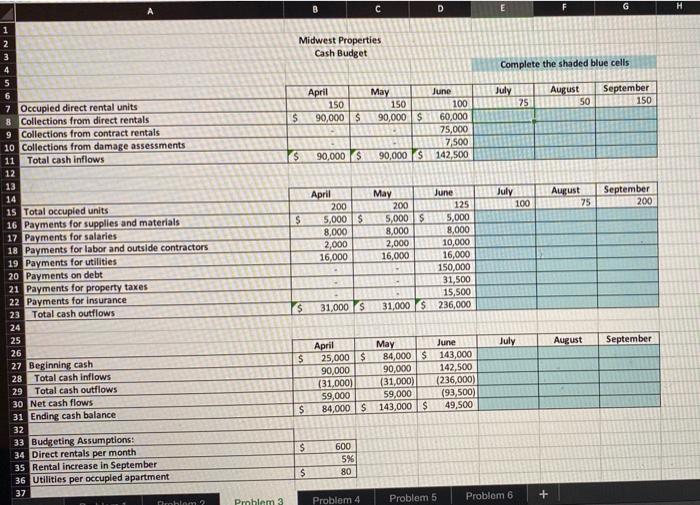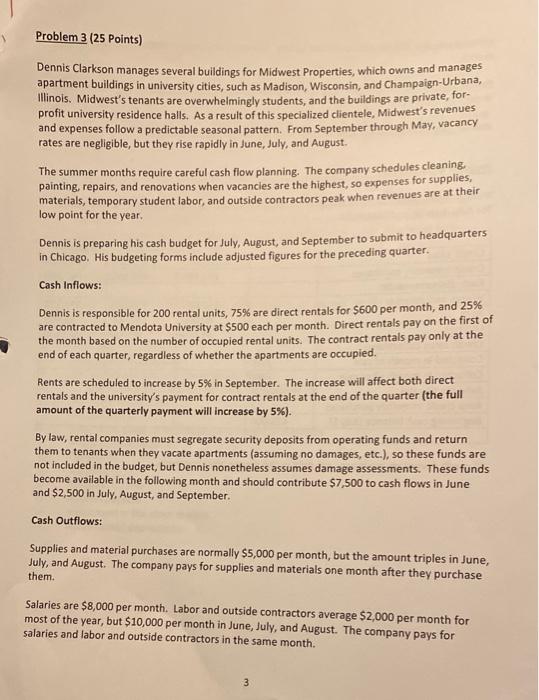1 2 Midwest Properties Cash Budget Complete the shaded blue cells 4 5 July April 150 90,000 $ August 50 September 150 75 $ May June 150 100 90,000 $60,000 75,000 7,500 90,000 $ 142,500 $ 90,000$ July 100 August 75 September 200 S April 200 5,000 $ 8,000 2,000 16,000 7 Occupied direct rental units 8 Collections from direct rentals 9 Collections from contract rentals 10 Collections from damage assessments 11 Total cash inflows 12 13 14 15 Total occupied units 16 Payments for supplies and materials 17 Payments for salaries 18 Payments for labor and outside contractors 19 Payments for utilities 20 Payments on debt 21 Payments for property taxes 22 Payments for insurance 23 Total cash outflows 24 25 26 27 Beginning cash 28 Total cash inflows 29 Total cash outflows 30 Net cash flows 31 Ending cash balance 32 33 Budgeting Assumptions: 34 Direct rentals per month 35 Rental increase in September 36 Utilities per occupled apartment 37 May June 200125 5,000 $5,000 8,000 8,000 2,000 10,000 16,000 16,000 150,000 31,500 15,500 31,000$ 236,000 $ 31,000 July August September $ April 25,000 $ 90,000 (31,000) 59,000 84,000 S May 84,000 $ 90,000 (31,000) 59,000 143,000 $ June 143,000 142,500 (236,000) (93,500) 49,500 $ $ 600 5% 80 $ + Problem 5 Problem 6 bo Pmhlam 3 Problem 4 Problem 3 (25 points) Dennis Clarkson manages several buildings for Midwest Properties, which owns and manages apartment buildings in university cities, such as Madison, Wisconsin, and Champaign-Urbana, Illinois. Midwest's tenants are overwhelmingly students, and the buildings are private, for profit university residence halls. As a result of this specialized clientele, Midwest's revenues and expenses follow a predictable seasonal pattern. From September through May, vacancy rates are negligible, but they rise rapidly in June, July, and August. The summer months require careful cash flow planning. The company schedules cleaning, painting, repairs, and renovations when vacancies are the highest, so expenses for supplies, materials, temporary student labor, and outside contractors peak when revenues are at their low point for the year Dennis is preparing his cash budget for July, August, and September to submit to headquarters in Chicago. His budgeting forms include adjusted figures for the preceding quarter. Cash Inflows: Dennis is responsible for 200 rental units, 75% are direct rentals for $600 per month, and 25% are contracted to Mendota University at $500 each per month. Direct rentals pay on the first of the month based on the number of occupied rental units. The contract rentals pay only at the end of each quarter, regardless of whether the apartments are occupied. Rents are scheduled to increase by 5% in September. The increase will affect both direct rentals and the university's payment for contract rentals at the end of the quarter (the full amount of the quarterly payment will increase by 5%). By law, rental companies must segregate security deposits from operating funds and return them to tenants when they vacate apartments (assuming no damages, etc.), so these funds are not included in the budget, but Dennis nonetheless assumes damage assessments. These funds become available in the following month and should contribute $7,500 to cash flows in June and $2,500 in July, August, and September. Cash Outflows: Supplies and material purchases are normally $5,000 per month, but the amount triples in June, July, and August. The company pays for supplies and materials one month after they purchase them. Salaries are $8,000 per month. Labor and outside contractors average $2,000 per month for most of the year, but $10,000 per month in June, July, and August. The company pays for salaries and labor and outside contractors in the same month. Utilities average $80 per occupied apartment. The company pays utilities in the following month. Payments of $150,000 on debt, $31,500 for property taxes, and $15,500 for insurance are paid in the last month of each quarter









